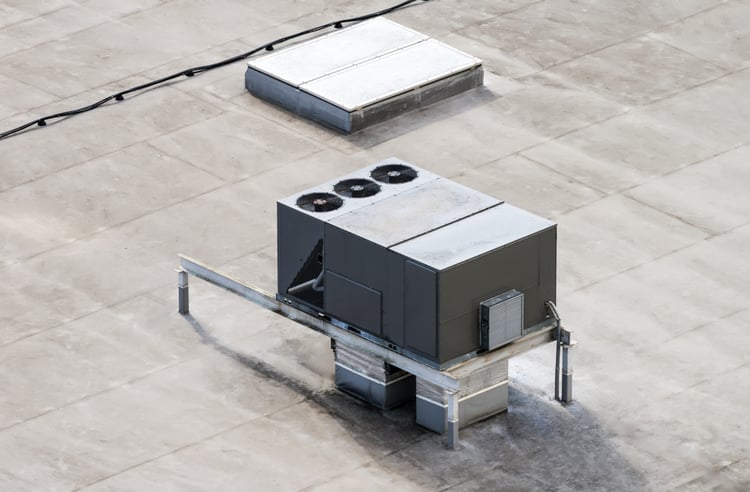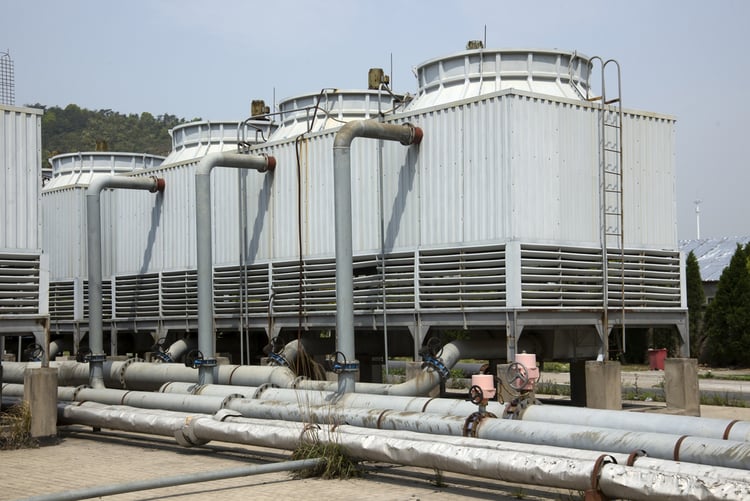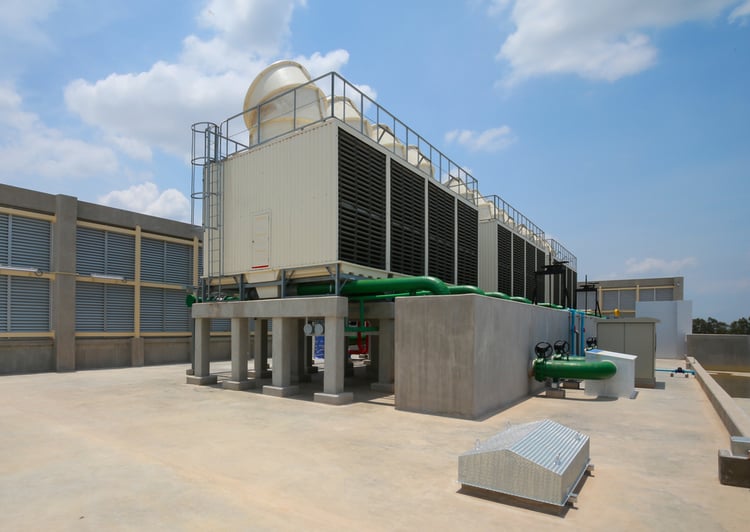Commercial Cooling System Drawings Tower
In commercial buildings, HVAC loads normally represent the highest energy expense. Geographic location plays a meaning role: buildings far to the north or south of the world typically take loftier heating expenses, while those located in the tropics may require air workout all twelvemonth long.
Just similar in residential settings, there is a wide range of heating and cooling options for commercial buildings, each with advantages and limitations. 3 of the most unremarkably used systems for commercial buildings are:
- Variable-air-book (VAV) systems with a packaged rooftop unit
- Chiller, cooling belfry and boiler systems
- H2o-source oestrus pump systems with a cooling tower and boiler
Are you planning a commercial real manor projection? Get a professional person HVAC blueprint.

ane) VAV System with Packaged Rooftop Unit
 Packaged rooftop units (RTUs) normally include a condenser for air conditioning, and a gas or electric boiler for space heating. In climates where the unit must provide air-conditioning with low outdoor humidity, information technology is as well possible to add an economizer, which reduces the cooling load on the condenser. In all modes of functioning, fans are used to accident air into a duct system that distributes it among the split up indoor zones.
Packaged rooftop units (RTUs) normally include a condenser for air conditioning, and a gas or electric boiler for space heating. In climates where the unit must provide air-conditioning with low outdoor humidity, information technology is as well possible to add an economizer, which reduces the cooling load on the condenser. In all modes of functioning, fans are used to accident air into a duct system that distributes it among the split up indoor zones.
- Each zone has a variable-air-volume (VAV) box with a damper that opens and closes according to cooling or heating needs.
- Damper position is controlled based on the temperature fix bespeak of each specific zone. For example, the damper will fully open if a specific zone requires maximum cooling or heating output.
Traditional VAV systems endure a drastic reduction in energy efficiency when bailiwick to part load weather: if all building zones are at fractional load with their dampers half-closed, duct force per unit area increases and the organisation may become noisy. In addition, the extra force per unit area represents wasted fan power. Nonetheless, information technology is possible to achieve excellent results through the use of automation and variable frequency drives:
- A control system constantly assesses the country of all VAV boxes. Ideally, at to the lowest degree one of them should be fully open; otherwise, fan power is existence wasted.
- If none of the dampers is fully open, fan speed is reduced and all dampers are opened gradually until one of them reaches the fully open up position.
- At this point, the fan is providing only the right airflow for the current HVAC load.
There can be considerable savings on fan power when speed is controlled through a variable frequency drive. In general, fan power is proportional to speed cubed – a fan running at 90% speed merely consumes effectually 73% of the energy it would consume at total speed. An added benefit of speed control is that noise is drastically reduced.
VAV systems with packaged rooftop units are practical in facilities that have a large rooftop area in proportion to their indoor floor space, given that air is the primary medium used to transport estrus. These systems are not applied in multi-story buildings due to the limited rooftop area and the long vertical distances involved; systems based on water-cooled chillers or h2o-source oestrus pumps are preferred in these applications.
2)Chiller with Cooling Tower and Boiler
 These systems use h2o as a medium to evangelize or extract heat, and water circuits pass through air-treatment units (AHUs) that provide the required airflow for each building zone.
These systems use h2o as a medium to evangelize or extract heat, and water circuits pass through air-treatment units (AHUs) that provide the required airflow for each building zone.
- In cooling mode, the chiller extracts heat from the cold water circuit that circulates through the building, and rejects information technology into a secondary water loop that is connected to the cooling belfry. The cooling tower then rejects the estrus outdoors.
- In heating style, the circulating water passes through a boiler. Most boilers are powered by electricity, gas or oil.
In both cases, heat is exchanged between the circulating water and the indoor air at the AHUs. If the chiller and banality share a h2o circuit (two-pipe system), the entire building must operate in either heating or cooling mode; even so, when in that location is a separate water excursion for each mode of operation (iv-pipage organisation), simultaneous heating and cooling tin can be provided to dissimilar zones. Of course, a four-pipe system is more expensive considering pipage and accessories are essentially doubled.
Just similar in the instance of VAV systems, it is possible to achieve considerable savings with command and automation:
- Modern chillers typically come with variable-speed compressors, which can operate efficiently even under part-load conditions. Some models combine speed control with staged operation to farther enhance efficiency.
- Variable speed drives can be used for multiple system components, including cooling tower fans, water pumps and air-treatment units.
- There are besides economizers for water-cooled systems, but they only apply for specific climate zones, where the system will provide air workout with depression outdoor humidity.
Chiller-based systems typically offer a higher efficiency than VAV systems, and are also more than practical for multi-story buildings: rather than having several packaged rooftop units, information technology is possible to consolidate the system into a single chiller and cooling belfry, and only the cooling tower has to be located outdoors or on the rooftop.
3) Water-Source Heat Pump System with a Cooling Tower and Boiler
 Commercial HVAC systems based on h2o-source heat pumps tend to exist the superior pick in terms of versatility and free energy efficiency. Heat pumps are based on the refrigeration bike, just like air conditioners, but they offer reversible operation; when multiple estrus pumps are used to serve separate areas of a commercial edifice, they tin can switch betwixt cooling and heating modes as needed.
Commercial HVAC systems based on h2o-source heat pumps tend to exist the superior pick in terms of versatility and free energy efficiency. Heat pumps are based on the refrigeration bike, just like air conditioners, but they offer reversible operation; when multiple estrus pumps are used to serve separate areas of a commercial edifice, they tin can switch betwixt cooling and heating modes as needed.
- All heat pumps in a building share a common h2o circuit, and they will either decline or blot heat depending on the needs of each zone.
- Since the water circuit it shared, equal heating and cooling loads residual each other out.
- If the cooling load is higher, a cooling tower is used to reject the actress oestrus; on the other hand, if the heating load is higher, a boiler is used to recoup for the difference.
Just like in the two previous scenarios, it is possible to make the organisation fifty-fifty more efficient by adding speed control to all pumps and fans used. Heat pumps are amongst the most efficient heating and cooling systems in the market: they tin can lucifer or surpass the efficiency of a chiller in cooling mode, and in most cases they can provide space heating with less than xl% of the energy consumption of a resistance heater.
The need to install a dedicated heat pump for each edifice zone drives up the cost of these systems, but this is compensated in the long term thank you to the superior free energy efficiency achieved. For case, if there is a moment when cooling and heating loads are equal, this arrangement tin operate with both the boiler and cooling tower deactivated.
Conclusions
I of the about of import design choices in a commercial building is HVAC configuration, since this organization represents a significant portion of ownership costs in the long term. Building layout is an important consideration: low-pinnacle facilities with ample rooftop areas tend to favor packaged rooftop units with VAV systems, while multi-story buildings tend to favor the use of chillers or water-source estrus pumps.
Of course, there are viable energy efficiency enhancements that tin be deployed in all cases. Modulating the speed of compressors, pumps and fans is more free energy-efficient than cycling these pieces of equipment on and off, and it also contributes towards a longer service life and reduced maintenance expenses.
Source: https://www.ny-engineers.com/blog/heating-and-cooling-system-configurations-for-commercial-buildings
Postar um comentário for "Commercial Cooling System Drawings Tower"